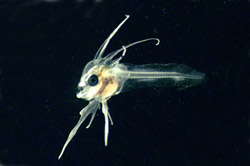Pictures from a microscopic world

Larvae of monkfish/anglerfish (Lophius vomerinus) ca. 5mm. The dorsal, pectoral and pelvic fins are very elongate at this stage.
The planktonic eggs and larvae are small and are best viewed through a microscope and therefore unknown to most people. Many of the species or close relatives are found also in more northern waters, and species such as monkfish, pearlside, horse mackerel, blackbelly rosefish (jacopever), gurnard and John dory are well known.
During our surveys in Namibia and South Africa we manage to identify most eggs and larvae. Since this is a relatively cold upwelling area, few species dominates and these are well documented in the literature even in the egg and larval stages. The challenge increases when we sometimes cross the front between the cold Benguela water and the warmer water of the Angola current. The number of species increase and many of the species are not well documented on the egg and larval stage.
In cooperation with local institutions, IMR has conducted several hake surveys in the region. The main goal has been to assess the stock size, but recently the focus has been directed towards life history studies and particularly to investigate whether the stocks of hake are shared between Namibia and South Africa. During last year's survey, we tried to map the spawning areas and the eggs and larval drift routes.
Media Contact
More Information:
http://www.imr.no/english/news/news_2006/a_microscopic_worldAll latest news from the category: Ecology, The Environment and Conservation
This complex theme deals primarily with interactions between organisms and the environmental factors that impact them, but to a greater extent between individual inanimate environmental factors.
innovations-report offers informative reports and articles on topics such as climate protection, landscape conservation, ecological systems, wildlife and nature parks and ecosystem efficiency and balance.
Newest articles

A universal framework for spatial biology
SpatialData is a freely accessible tool to unify and integrate data from different omics technologies accounting for spatial information, which can provide holistic insights into health and disease. Biological processes…

How complex biological processes arise
A $20 million grant from the U.S. National Science Foundation (NSF) will support the establishment and operation of the National Synthesis Center for Emergence in the Molecular and Cellular Sciences (NCEMS) at…

Airborne single-photon lidar system achieves high-resolution 3D imaging
Compact, low-power system opens doors for photon-efficient drone and satellite-based environmental monitoring and mapping. Researchers have developed a compact and lightweight single-photon airborne lidar system that can acquire high-resolution 3D…





















